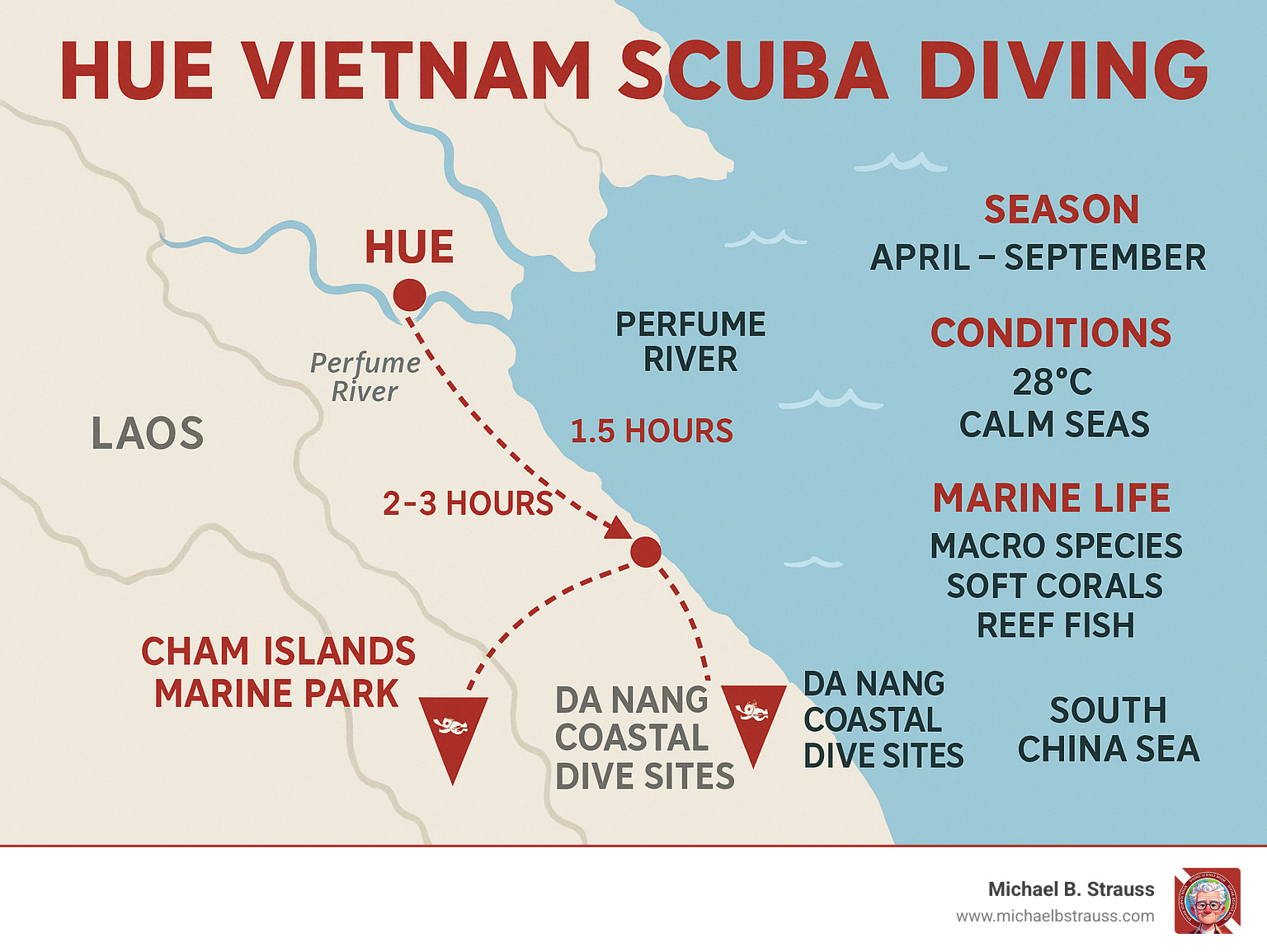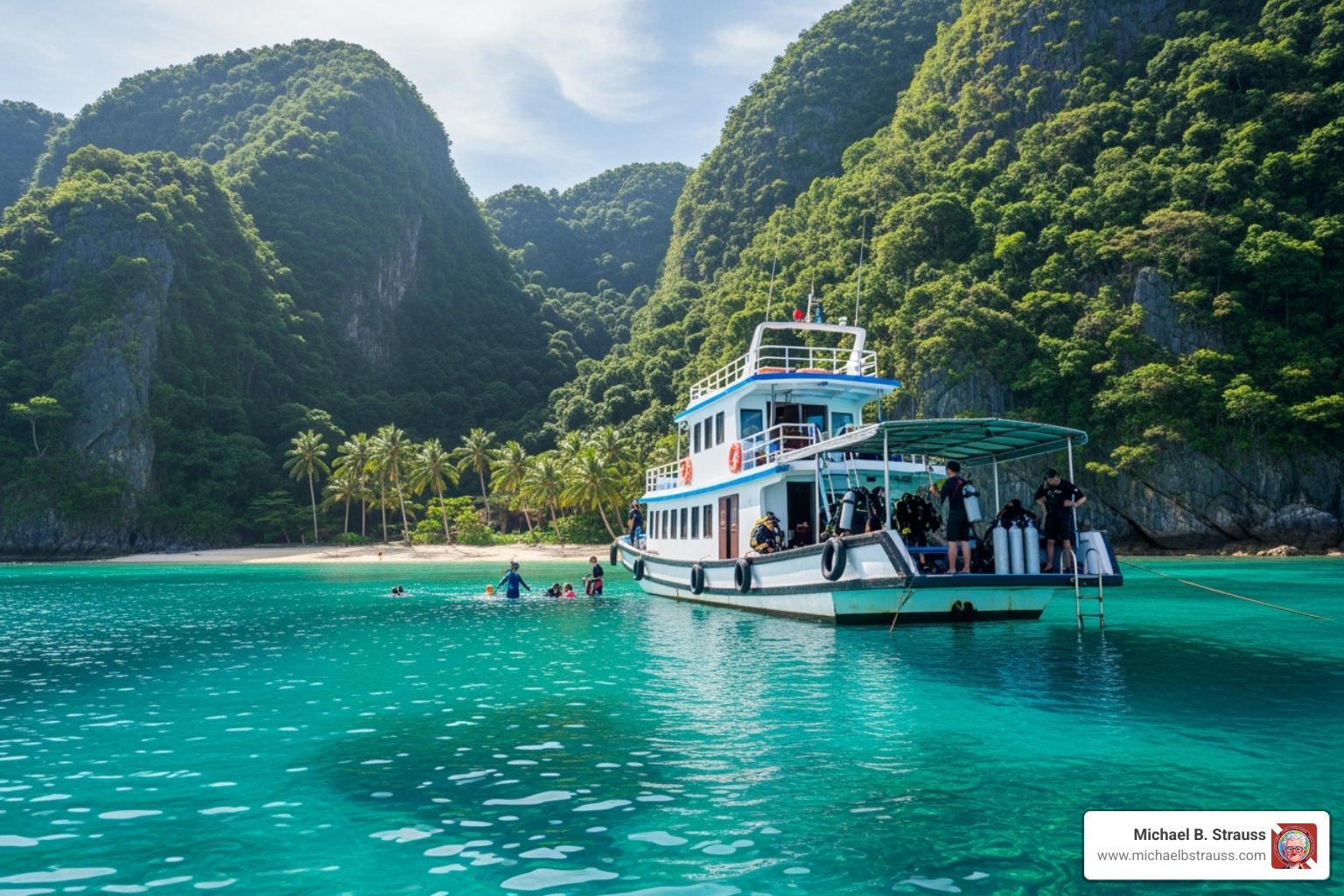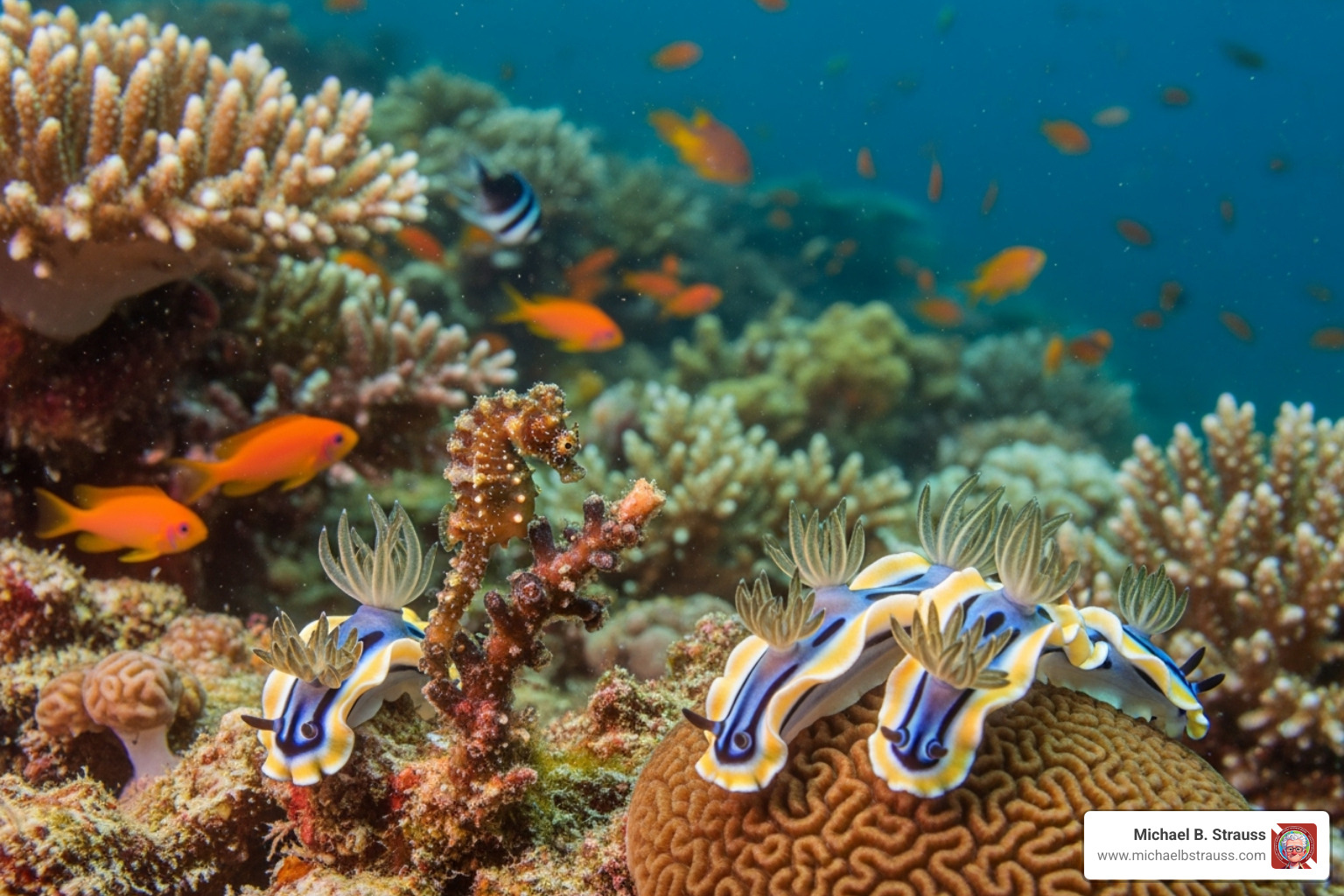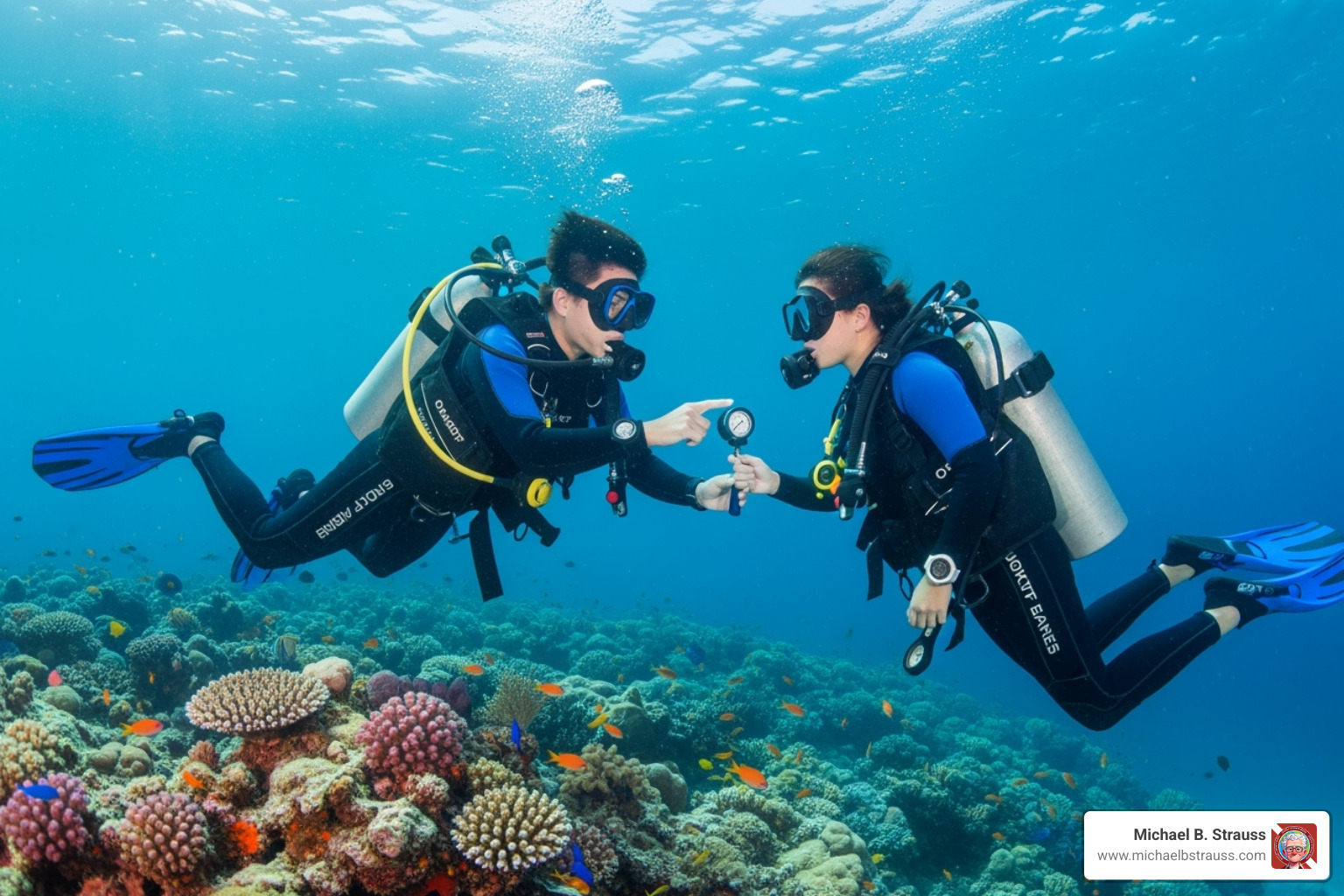Introduction to Diving Near Vietnam's Imperial City
Hue vietnam scuba diving presents a unique opportunity to combine Vietnam's rich imperial history with access to some of Central Vietnam's most pristine underwater environments. While the ancient capital sits along the scenic Perfume River rather than directly on the coast, it serves as an excellent base for exploring the region's diverse marine ecosystems.
Quick Answer for Hue Vietnam Scuba Diving:
- Direct diving in Hue: Limited - the city is inland along the Perfume River
- Best nearby options: Cham Islands (2-3 hours), Da Nang coastal sites (1.5 hours)
- Optimal season: April to September for calm seas and best visibility
- Water conditions: 28°C temperature, visibility varies by location and season
- Marine life: Macro species, soft corals, tropical reef fish, seahorses
Vietnam has emerged as a rising star among Southeast Asia's scuba diving destinations, with its 3,000+ kilometer coastline offering incredible biodiversity and largely unexplored underwater territories. Central Vietnam, in particular, remains relatively unfinded by diving enthusiasts, creating opportunities for more adventurous divers to explore pristine sites.
From Hue's strategic location, you can access multiple marine environments within a few hours' travel. The nearby Cham Islands offer protected marine park diving, while the Son Tra Peninsula near Da Nang provides unexplored diving potential in calm, clear waters.
The region's tropical climate allows for year-round diving, though the best conditions occur during the dry season. Water temperatures remain consistently warm at around 28°C, requiring only a 3mm wetsuit for comfortable diving.

Explore more about hue vietnam scuba diving:
The Reality of Hue Vietnam Scuba Diving and Your Best Nearby Options
Let's be honest about Hue Vietnam scuba diving from the start. Hue is absolutely magical - this ancient imperial capital will steal your heart with its majestic palaces, tranquil pagodas, and the gentle flow of the Perfume River. You could spend weeks getting lost in the Imperial City's history or listening to traditional music drift through the evening air.
But here's the thing: Hue sits inland along the Perfume River, which means direct coastal reef access is pretty much non-existent. You won't find dive boats bobbing alongside the dragon boats, and there aren't any coral reefs hiding beneath those historic bridges.
Before you feel disappointed, let me share why this is actually perfect. Think of Hue as your culturally rich home base for exploring Central Vietnam's incredible underwater world. After spending your morning wandering through emperor's tombs and your afternoon savoring royal cuisine, you can look forward to an amazing diving trip just a short trip away.
The beauty lies in the accessible dive sites within Central Vietnam that are absolutely worth the journey from Hue. We're talking about the Cham Islands Marine Park near Hoi An and the pristine coastal areas around Da Nang, including the largely unexplored Son Tra Peninsula. These spots offer vibrant marine ecosystems that rival any of Vietnam's famous diving destinations.
Exploring Central Vietnam's Dive Sites from Hue
Ready to trade ancient temples for coral gardens? The underwater treasures of Central Vietnam are closer than you might think.

The Cham Islands are your main destination, and they're absolutely spectacular. This UNESCO Biosphere Reserve consists of 8 islands with the protected Cu Lao Cham Marine Park at its heart. What makes this place special? The protected status means healthier reefs and more pristine diving than many other Southeast Asian destinations.
Here's what's exciting: Central Vietnam's diving scene remains relatively unexplored. While thousands of divers flock to other Vietnamese hotspots each year, these waters still hold that sense of findy that makes every dive feel like an trip.
Getting there is straightforward from Hue. A scenic bus ride to Da Nang takes about 1.5 to 2 hours, including the breathtaking journey over Hai Van Pass. Trains also connect the cities if you prefer a more relaxed ride. From Da Nang or nearby Hoi An, dive operators handle the boat transfers to your dive sites.
Day trips are the most popular option, and they're well-organized. Most excursions include lunch, multiple dives, and snorkeling opportunities for non-divers in your group. The dive centers in the area maintain small group sizes and emphasize safety, making it perfect for both beginners seeking their first underwater experience and certified divers looking for fun dives.
What really gets me excited is the unexplored potential of this region. While the Cham Islands see regular diving activity, areas around the Son Tra Peninsula remain largely unfinded. This means you might encounter marine life that hasn't grown wary of humans, and you could be among the first to explore certain sites.
Marine Life and Typical Dive Conditions
Central Vietnam's waters might not be famous for whale sharks or manta rays, but the macro life and reef ecosystems here are absolutely incredible.

The reefs burst with tropical fish - clownfish playing in their anemones, graceful angelfish, vibrant butterflyfish, and busy parrotfish munching on coral. Lionfish pose dramatically in the current, while pipefish and seahorses hide among the soft corals, waiting for patient photographers to spot them.
Nudibranchs are the real stars here. These tiny sea slugs come in colors that seem impossible - electric blues, neon oranges, and patterns that look hand-painted. Macro photographers absolutely love this region for these little gems.
Keep your eyes open for schooling barracudas and trevallies cruising the reef edges. In the nooks and crannies, you'll find cuttlefish, octopus, and scorpionfish masters of camouflage. Hawksbill turtles glide gracefully through the water columns, and if you're lucky, you might spot a bamboo shark or blue-spotted ray in areas with stronger currents.
The water temperature stays around 28°C (82°F) year-round, which means comfortable diving in just a 3mm wetsuit. You can stay underwater longer without getting cold, which is always a bonus.
Visibility varies depending on recent weather and specific sites, but during the optimal season, the water is beautifully clear. April through September offers the best diving conditions, with calmer seas and excellent visibility. This dry season timing means pleasant surface conditions too, making your entire diving day more enjoyable.
The unique marine ecosystems here showcase vibrant coral formations, dramatic rock structures, and even some submerged forest areas. Most recreational dives stay around 25 meters depth, making them accessible for all certification levels.
For a deeper understanding of how diving affects your body and improves safety underwater, check out Diving Science. This knowledge makes every dive both safer and more enjoyable.
A Glimpse at Vietnam's Other Premier Dive Destinations
While we're focusing on Hue Vietnam scuba diving opportunities, Vietnam's diving scene extends far beyond Central Vietnam, and it's worth understanding what makes this region special in the bigger picture.
Nha Trang to the south has earned its reputation as Vietnam's diving capital. It's known for calm currents, clear waters, and over 20 dive operators offering everything from beginner courses to advanced training. Hon Mun Marine Park showcases excellent macro life and reef ecosystems.
Phu Quoc Island in the far south offers mostly unspoiled waters where new sites are still being finded. The An Thoi archipelago's 15 islets provide more challenging diving with potential bamboo shark and ray encounters for experienced divers.
Con Dao Islands remain extremely remote and well-protected, with many considering them to offer Vietnam's best diving. The pristine coral reefs and unique ecosystem make encounters with barracuda, moray eels, and sea turtles more common.
What sets Central Vietnam apart from these established destinations is its sense of findy. While those other locations are fantastic, the areas accessible from Hue offer less crowded sites and the genuine thrill of exploring relatively unknown underwater territories. You get the perfect combination - rich cultural immersion in Hue paired with pioneering dive experiences that feel authentically adventurous.
Planning Your Safe and Memorable Dive Trip
Planning your hue vietnam scuba diving trip should fill you with excitement, not anxiety. While the underwater world offers incredible beauty and wonder, approaching it with the right preparation and safety mindset ensures every dive becomes a treasured memory rather than a cautionary tale.
The key to a successful diving trip lies in three fundamental areas: thorough preparation, choosing quality operators, and understanding the costs involved. When you're based in Hue and planning to explore Central Vietnam's underwater treasures, taking time to plan properly pays dividends in both safety and enjoyment.
Think of preparation as your underwater insurance policy. The more thoroughly you prepare, the more confidently you can focus on the amazing marine life and coral formations waiting beneath the surface. This preparation extends beyond just booking a dive – it involves understanding your own comfort level, researching operators, and being honest about your experience and expectations.
Choosing the Right Dive Course and Operator
Whether you've never breathed underwater or you're a seasoned diver looking to explore new sites, Central Vietnam's dive operators offer programs custom to every skill level. Introductory experiences like "Try Scuba" or "Find Scuba Diving" programs are perfect for testing the waters – literally. These programs typically include a brief classroom session, some pool or shallow water practice, and one or two supervised open water dives.
For those ready to take the plunge into certification, the PADI Open Water Course remains the gold standard for entry-level certification. This course opens the door to independent diving with a buddy anywhere in the world. Advanced training options like the PADI Advanced Open Water Course expand your skills and depth limits, while specialty programs in underwater photography, night diving, or marine conservation can deepen your connection to the underwater world.

Selecting the right operator can make or break your diving experience. Look for PADI or SSI affiliated centers that maintain international safety standards and employ properly certified instructors. These affiliations aren't just fancy logos – they represent a commitment to proven training methods and safety protocols.
The best operators are transparent about their safety procedures and equipment maintenance schedules. They'll happily discuss their emergency action plans and show you their well-maintained gear. In the Cham Islands area, accessible from Hue, many operators pride themselves on experienced crews with thousands of logged hours and comprehensive knowledge of local conditions.
Small group sizes make an enormous difference in your learning experience and safety. When your instructor can focus on just a few students instead of herding a large group, you receive personalized attention that builds confidence and competence. Many quality centers limit classes to just 2-4 students per instructor, ensuring you're not just another face in the crowd but a valued student whose progress matters.
Key Safety Considerations for Diving in Vietnam
Safety underwater starts with understanding two critical concepts: decompression sickness awareness and proper equalization techniques. Decompression sickness, while uncommon, occurs when we ascend too quickly, allowing nitrogen bubbles to form in our tissues. The prevention is straightforward – follow your dive computer or tables, make slow controlled ascents, and never skip safety stops.
Equalization – the process of balancing pressure in your ears and sinuses during descent – requires gentle, frequent attention. If you're having trouble equalizing, signal your instructor immediately. Forcing it or ignoring discomfort can lead to serious injury.
Every quality dive operation emphasizes thorough dive planning and professional consultation. Your dive briefing isn't just a formality – it's your roadmap to a safe, enjoyable dive. Pay attention to site-specific information, current conditions, and emergency procedures. Don't hesitate to ask questions or voice concerns about your comfort level.
For deeper insights into decompression risks and prevention, we recommend reading Why and at What Sites Decompression Sickness Can Occur. Knowledge truly is power when it comes to diving safety.
Dive insurance deserves serious consideration, even for short trips. While operators prioritize safety, accidents can happen anywhere. DAN (Divers Alert Network) insurance provides specialized coverage for diving-related medical emergencies and evacuations. It's a small investment that delivers enormous peace of mind, allowing you to fully immerse yourself in the experience. You can explore coverage options at DAN Insurance.
Budgeting for Your Scuba Diving Excursion
Understanding the cost structure of your hue vietnam scuba diving trip helps you budget effectively and avoid surprises. Vietnam offers excellent value for diving experiences compared to many international destinations, making it accessible for various budgets.
Your diving expenses will typically fall into these categories:
- Fun dives for certified divers include boat transportation, tank and weight rental, and professional guidance
- Introductory scuba programs cost more than single fun dives due to the included instruction and direct supervision
- Certification courses like Open Water or Advanced Open Water represent larger investments but provide lifetime skills and credentials
- Equipment rental fees vary depending on what's included in your package versus specialized gear you might want
- Marine park entrance and conservation fees contribute to protecting the beautiful sites you're exploring
The protected status of sites like the Cham Islands means part of your diving fee supports conservation efforts – a small price for preserving these underwater treasures for future generations. By understanding these cost categories upfront, you can plan your budget and focus on what matters most: creating unforgettable underwater memories from your base in historic Hue.
To deepen your knowledge of diving physiology and safety, get your copy of Diving Science Revisited.
DISCLAIMER: Articles are for "EDUCATIONAL PURPOSES ONLY", not to be considered advice or recommendations.






